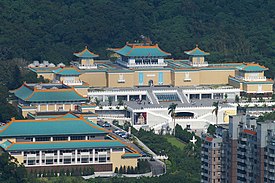National Palace Museum
| 國立故宮博物院 | |

Logo
|
|
 |
|
| Established |
10 October 1925 (in Jingzhao Difang) 12 November 1965 (in Taipei) |
|---|---|
| Location | Shilin District, Taipei, Republic of China |
| Type | National museum |
| Collection size | 696,422 (as of December 2016) |
| Visitors | 6,142,892 (2016) Ranking 6th globally (2015) |
| Director | Lin Jeng-yi |
| Website | south.npm.gov.tw |
| National Palace Museum | |||||||||||||||
| Traditional Chinese | 國立故宮博物院 | ||||||||||||||
|---|---|---|---|---|---|---|---|---|---|---|---|---|---|---|---|
| Simplified Chinese | 国立故宫博物院 | ||||||||||||||
|
|||||||||||||||
| Transcriptions | |
|---|---|
| Standard Mandarin | |
| Hanyu Pinyin | Guólì gùgōng bówùyuàn |
| Wade–Giles | Kuo2-li4 ku4-kung1 po2-wu4-yüan4 |
| IPA | [kwǒlî kûkʊ́ŋ pɔ̌.û.ɥɛ̂n] |
| Southern Min | |
| Tâi-lô | Kok-li̍p kòo-kiong phok-bu̍t-kuán |
The National Palace Museum is located in Taipei and Taibao, Taiwan (Republic of China). It has a permanent collection of nearly 700,000 pieces of ancient Chinese imperial artifacts and artworks, making it one of the largest of its type in the world. The collection encompasses 8,000 years of history of Chinese art from the Neolithic age to the modern. Most of the collection are high quality pieces collected by China's emperors.
The National Palace Museum and the Palace Museum in the Forbidden City in Beijing, mainland China, share the same roots. The National Beiping Palace Museum in Beiping split in two as a result of the Chinese Civil War, which divided China into the two entities of the Republic of China (ROC) on the island of Taiwan and the People's Republic of China (PRC) on the mainland respectively. In English, the institution in Taipei is distinguished from the one in Beijing by the additional "National" designation. In common usage in Chinese, the institution in Taipei is known as the "Taipei Former Palace" (臺北故宮), while that in Beijing is known as the "Beijing Former Palace" (北京故宮).
The National Palace Museum was originally established as the Palace Museum in Jingzhao Difang's Forbidden City on 10 October 1925, shortly after the expulsion of Puyi, the last emperor of China, from the Forbidden City by warlord Feng Yü-hsiang. The articles in the museum consisted of the valuables of the former Imperial family.
...
Wikipedia
